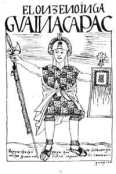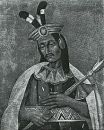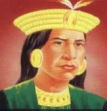Hello! This is the final chapter of a multi-part series on the Inca Empire and the Conquistadors. If you want some background, the introduction to this series is right here, and part twenty two is here. For those of you who like to have no idea what’s going on, go ahead!
After Gonzalo Pizarro had executed Nunez Vela, his second-in-command Francisco Carvajal urged Pizarro to declare himself King of Peru. This idea was not as fanciful as it might seem. All of Gonzalo’s rivals in Peru were dead – The Almagristas were all dead, and Nunez Vela had left no supporters. The older conquistadors in Peru either supported Gonzalo or had no interest in challenging him. There was a Spanish presence in Panama and Mexico, but their forces there were too preoccupied with their own issues to seriously consider intervening against him.
Gonzalo, although he allegedly considered the possibility of declaring himself king, outwardly made no such claim. Gonzalo’s dreams were smaller, although still considerable. He wanted to be governor of Peru, a position that he had already seized for himself, but he wanted for the king to officially acknowledge him as the governor. For Gonzalo, this seemed to be the fair and reasonable choice. He and his brothers had helped win Peru for the crown, a property that was sending still sending the crown thousands of pounds of silver a month. Gonzalo could argue quite persuasively that Emperor Charles V had gotten rich on the backs of the Pizarro brothers, so the least he could do was to throw him a bone. Gonzalo had deposed the king’s viceroy, it’s true, but Nunez Vela had been a disliked and unpopular viceroy who had imposed tyrannical rules on the people of Peru, so in killing him Gonzalo believed he had actually been serving Charles V’s interests.
If Emperor Charles V would just acknowledge him as governor, Gonzalo believed, a title that he already had de facto, then Gonzalo would be a loyal governor and the governance of Peru would go smoothly.
However, Emperor Charles V had no interest in working with the man who had executed his chosen viceroy. He immediately sent another viceroy to fill Nunez Vela’s position and take care of Gonzalo.
The man he chose, Pedro de la Gasca, arrived in Panama in late 1546. De la Gasca had no army, no navy and no money, all he had was a piece of paper from Emperor Charles V granting him unquestioned authority over Peru. Gonzalo, meanwhile, had thousands of heavily armed men, a large navy and all of Peru behind him.
Gonzalo was an excellent fighter and a skilled tactician, and his second-in-command Carvajal was perhaps even more talented at waging war. However, de la Gasca had a more valuable skill – he was a better politician. De la Gasca recognized that Gonzalo’s support was built upon opposition to the New Laws, and that he was capitalizing on the conquistadors’ anger to propel himself to power. With that in mind, de la Gasca moved to cut this pillar out from under Gonzalo.
As soon as he arrived in Panama, de la Gasca was accosted by Gonzalo’s officers. Gonzalo’s fleet was anchored at port, and the town was full of Gonzalo’s soldiers. De la Gasca, outnumbered and vastly outgunned, sized up the situation calmly. He reminded the officers of their oaths to the emperor, and their duty to their homeland. Finally, he calmly mentioned his plans – he intended to repeal the New Laws, and to pardon any man who had participated in Gonzalo’s rebellion who surrendered to him. The officers glanced at each other incredulously. A repeal of the New Laws was all they had ever wanted, and to receive a royal pardon in addition was an amazing offer. Quickly, every officer there betrayed Gonzalo, joining de la Gasca. (de la Vega, loc. 25112)
De la Gasca had come to Panama with nothing. Now he had a navy.
The king’s viceroy sailed for Peru and landed in Tumbez in 1547. He had sent messengers across Peru spreading the promise he had made to all of Gonzalo’s men – a repeal of the New Laws, and a full pardon to any who joined him – and more and more of Gonzalo’s men came to join him every day. Gonzalo was not unaware of this threat and he and de la Gasca exchanged several messages and diplomatic envoys. However, these messages were not fruitful for either side. Gonzalo asked for de la Gasca to recognize him as governor, while de la Gasca offered to pardon Gonzalo for his role in the rebellion but insisted in no uncertain terms that Gonzalo step down. Neither man was willing to compromise on this point, so both sides prepared for war.
Gonzalo now found Peru beginning to slip out of his grasp without a single shot having been fired. He wrote to his men in the north, his garrisons in Quito, San Miguel and Trujillo, a stone’s throw from the viceroy’s base at Tumbez. Gonzalo urged his men to arm themselves and ready themselves for his signal. Instead his captains all deserted to de la Gasca, handing three hundred men and the north over to the viceroy. (de la Vega loc. 25404)
Gonzalo sent men towards Cuzco to raise his forces there, but they were ambushed by royalist forces and many of Gonzalo’s men deserted. Gonzalo was fuming in Lima when the first ships from de la Gasca sailed into the harbor. These ships didn’t carry soldiers, though. Instead they carried an envoy who had brought dozens of copies of de la Gasca’s proclamation that he would repeal the New Laws and pardon anyone who surrendered to him. While one of the envoys wasted Gonzalo’s time, the letters were quickly passed around Lima, handed to Gonzalo’s most powerful supporters and strewn in the streets. In a few days, all of Lima knew of the viceroy’s generosity and Gonzalo’s supporters began deserting him en masse.In disgrace, Gonzalo was forced to retreat from Lima as the city turned against him. (de la Vega, loc. 25864)
At this point, most men might have surrendered to the viceroy. De la Gasca had offered him a full pardon, and Gonzalo would still be one of the most powerful and richest men in Peru. Gonzalo wasn’t like most men, though. It was the governor’s seat he wanted, and he wouldn’t stop until he got it.
Gonzalo and Carvajal gathered all the men they could and left Lima, heading south to their supporters at Arequipa. At Arequipa Gonzalo decided to continue heading southeast, far enough away from the viceroy that he could build up his power and rule a province there. Gonzalo’s forces were bolstered by the arrival of a loyal captain and the garrison at Arequipa, but his forces continued to be plagued by desertion. Gonzalo’s initial force of 1300 men shrunk to 400 men as they marched from Lima and out of Arequipa. Carvajal insisted that the remaining soldiers pick up and carry the deserters’ abandoned weaponry, especially their arquebuses, so the soldiers were overburdened and exhausted. Gonzalo’s army marched southeast, tired, demoralized and slow.
The bad news only worsened for Gonzalo – the royalist captain Diego Centeno had heard news of Gonzalo’s arrival and had mustered his forces to intercept him at the plains of Huarina. Pulling from all the royalist troops in the area, Centeno quickly raised a massive army of 1200 men – 250 horsemen, 800 pikemen and 150 arquebusiers, – an army that easily dwarfed Gonzalo’s army. (de la Vega loc. 26029)
Gonzalo, for his part, had only 400 men – 85 horsemen, 65 pikemen and 250 arquebusiers. In addition, Gonzalo’s men were exhausted from their long march and demoralized from the constant desertions of their friends and comrades. Centeno was almost certainly already celebrating his victory – bringing a captive Gonzalo to de la Gasca would undoubtedly be well rewarded – and his men told their servants to prepare double the amount of food, as they would invite their captive enemies to dine with them after the battle. (de la Vega loc. 26061)

The armies of Gonzalo and Centeno faced each other across Huarina. Carvajal commanded Gonzalo’s army, and he held his men firmly in place as Centeno’s forces advanced. Gonzalo himself, mounted with the cavalry, wanted to charge forward and engage Centeno, but Carvajal urged patience. Centeno’s huge army continued to inch forward, and Gonzalo’s army simply stood there.
Slightly confused, Centeno continued to move forward until his army was a hundred paces from Gonzalo’s. Then Centeno’s world exploded.
A devastating arquebus volley ripped through Centeno’s men, then another volley followed, reaping horrible damage on Centeno’s men, who collapsed to the ground screaming as the lead balls punched through armor, flesh and bone. The battlefield filled with the smells of gunpowder and gore, while Gonzalo’s men stood untouched.
Earlier in the march from Lima, Carvajal had insisted that even as men deserted, the deserters’ weapons should be kept and carried by the remaining soldiers. Now that order was finally paying dividends. Each of Gonzalo’s 250 arquebusiers carried three or four arquebuses, giving his tiny army a high rate of firepower that belied the army’s size. They could not sustain that rate of fire in the heat of combat, and carrying so many heavy weapons exhausted his men. But in a surprise first volley, the effects were devastating. (de la Vega loc. 26092)
Centeno, shocked at the damage, unleashed his cavalry, which quickly routed Gonzalo’s outnumbered cavalry; Gonzalo barely escaped the melee with his life. Gonzalo’s surviving cavalry retreated to the protection of the infantry and the arquebusiers. Centeno’s cavalry attempted to charge the infantry, but waves of gunfire from the arquebusiers pushed them back. Centeno’s infantry continued to take heavy damage from the arquebusiers, and many of his men abandoned the fight to loot Gonzalo’s nearby camp. The remaining infantry charged Gonzalo’s men, where Gonzalo’s arquebuses and pikes made short work of them. The rest of Centeno’s men, including Centeno himself, broke and ran for the hills.
At the battle of Huarina, Gonzalo lost 70 men, almost all of them cavalry. Meanwhile, 350 of Centeno’s men were killed, with an additional 350 men wounded so seriously they were unable to continue. Of those casualties, 150 were killed in the first volley of arquebusier fire. (de la Vega loc. 26198)
Centeno’s army was completely shattered, and he personally fled to Lima. With Centeno’s army defeated, the road to Cuzco was clear. Gonzalo’s quest for the governorship was not over yet.
Gonzalo reached Cuzco, and immediately began raising his forces. Meanwhile news had reached de la Gasca of Centeno’s defeat, and he also began raising another army. The winter of 1547/1548 passed, and everyone in Peru knew what was going to happen next. De la Gasca himself would lead an army against Gonzalo in Cuzco.
In the spring of 1548, de la Gasca marched out of Lima with a huge army. When he neared Cuzco, Gonzalo brought his own army out to face him. On April 9, 1548, de la Gasca and Gonzalo’s armies established battle lines near Jaiquijahuana, less than 15 miles from Cuzco. Gonzalo had 1000 men, although he did not trust 300 of them, because they had been captured from Centeno’s defeat at Huarina. De la Gasca, meanwhile, had an army of 1600 men. (de la Vega loc. 26951). Gonzalo and Carvajal were outnumbered, but they had already won one amazing victory at Huarina, so de la Gasca was not inclined to take them lightly.
The two armies drew up to a distance where they could each see each other, but far out of arquebus range, and exchanged some desultory artillery fire. Then Gonzalo began to maneuver his forces into position.
What happened next could probably be considered a comedy, if the stakes had not been so high.
Gonzalo sent his skirmishers out to engage de la Gasca’s army. His arquebusiers moved into position, but as soon as they were a safe distance away, the arquebusiers sprinted towards de la Gasca’s lines, yelling that they were surrendering. Gonzalo sent additional men to run down the arquebusiers, but these men followed in their comrades’ footsteps and deserted as well. Next Gonzalo sent the cavalry out to attempt to instill some order, but they deserted him as well. The stream of soldiers from Gonzalo was constant now, with both enlisted men and famous officers deserting en masse. Finally, Gonzalo’s infantry dropped their pikes and sprinted towards de la Gasca’s lines. The entirety of Gonzalo’s army had deserted him. (de la Vega loc. 27079)
The only men left with Gonzalo now were Carvajal and five captains who had stayed by his side. Gonzalo chose to surrender rather fleeing, “for no enemy ever saw his back,” he handed his sword to one of de la Gasca’s men and rode his horse towards de la Gasca. (de la Vega loc. 27090)

De la Gasca only lost one man – a soldier accidentally killed by friendly fire.
Shortly after the Battle of Jaquijahuana, Gonzalo’s captains were executed. Next Carvajal was executed, taunting his captors during the whole ordeal. Finally, Gonzalo Pizarro was beheaded in a single stroke. (de la Vega loc. 27576)
The last of the Pizarros, and the last of the original conquerors of Peru, was dead.

Dates
c. 1200 Kingdom of Cuzco is founded
1438-1471 Reign of Pachachuti
1471-1493 Reign of Tupac Inca
1492 Columbus discovers the Americas
1493-1527 Reign of Huayna Capac
1526 Pizarro and his thirteen men discover the Inca city of Tumbez
1527 Huayna Capac dies of smallpox brought by the Europeans
1527-1531 Civil war between Atahualpa Inca and Huascar
1531 Pizarro’s conquering expedition to Peru, Pizarro captures Atahualpa Inca, Atahualpa executes his brother Huascar
1533 Pizarro executes Atahualpa Inca and installs Manco Inca as the new Inca
1535 Pizarro founds the city of Lima
1536 Manco Inca rebels against the Spanish, leads a massive uprising that traps them in Cuzco and Lima. Juan Pizarro is killed in the battle
1537 Diego Almagro seizes Cuzco from the Pizarros. Manco Inca retreats from the capital to Vilcabamba
1538 Hernando Pizarro defeats and executes Almagro
1540 Hernando Pizarro is sentenced to twenty years imprisonment in Spain for killing Almagro.
1541 Pizarro is assassinated by supporters of Almagro
1544 Manco Inca is assassinated by Pizarro’s assasins. Gonzalo Pizarro rebels against the viceroy Blasco Nunez Vela
1546 Gonzalo Pizarro defeats and executes Blasco Nunez Vela
1548 Gonzalo Pizarro is defeated and executed by Pedro de la Gasca
Characters
Incas

Huayna Capac – Emperor of the Incas [Died of plague in 1527]

Huascar – Son of Huayna Capac and the heir to the throne [Executed by Atahualpa in 1531]

Atahualpa – Brother of Huascar and rival for the throne, emperor of the Incas [Executed by Pizarro in 1533]

Manco Inca – Younger brother of Atahualpa and Huascar, emperor of the Incas [Executed by Pizarro’s killers in 1544]
The Pizarros

Francisco Pizarro – Oldest of the brothers and mastermind of the expedition. A talented leader of men and a good strategist [Assassinated by Diego Almagro II’s men in 1541]
Hernando Pizarro – Second of the brothers; a canny and calculating tactician [Sentenced to twenty years in prison in Spain in 1540]
Gonzalo Pizarro – Third brother; charming womanizer with a vicious cruel streak [Executed by Pedro de la Gasca in 1548]
Juan Pizarro – Youngest of the brothers and a powerful, impetuous soldier [Killed during the Siege of Cuzco by Manco Inca’s forces in 1536]
Almagristas

Diego Almagro – Partner with Pizarro and one of his oldest friends, a hardened veteran of many battles ready to strike it rich [Executed by Hernando Pizarro in 1538]
Diego Almagro II – Almagro’s son, a hot-headed young soldier [Executed by Gonzalo Pizarro and Cristobal Vaca de Castro in 1542]
Royalists
 Cristobal Vaca de Castro – Viceroy of Peru, a flexible and adaptable man [Returned to Spain in 1544]
Cristobal Vaca de Castro – Viceroy of Peru, a flexible and adaptable man [Returned to Spain in 1544]

Blasco Nunez Vela – Viceroy of Peru, grating and brusque administrator [Executed by Gonzalo Pizarro in 1546]
 Pedro de la Gasca – Viceroy of Peru, a clever politician and adept manipulator
Pedro de la Gasca – Viceroy of Peru, a clever politician and adept manipulator